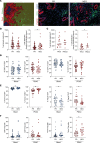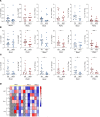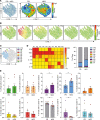Neoadjuvant chemotherapy drives intratumoral T cells toward a proinflammatory profile in pancreatic cancer
- PMID: 36509285
- PMCID: PMC9746809
- DOI: 10.1172/jci.insight.152761
Neoadjuvant chemotherapy drives intratumoral T cells toward a proinflammatory profile in pancreatic cancer
Abstract
BACKGROUNDPancreatic ductal adenocarcinoma (PDAC) has a dismal prognosis. At diagnosis, only 20% of patients with PDAC are eligible for primary resection. Neoadjuvant chemotherapy can enable surgical resection in 30%-40% of patients with locally advanced and borderline resectable PDAC. The effects of neoadjuvant chemotherapy on the cytokine production of tumor-infiltrating T cells are unknown in PDAC.METHODSWe performed multiplex immunofluorescence to investigate T cell infiltration in 91 patients with PDAC. Using flow cytometry, we analyzed tumor and matched blood samples from 71 patients with PDAC and determined the frequencies of T cell subsets and their cytokine profiles. Both cohorts included patients who underwent primary resection and patients who received neoadjuvant chemotherapy followed by surgical resection.RESULTSIn human PDAC, T cells were particularly enriched within the tumor stroma. Neoadjuvant chemotherapy markedly enhanced T cell density within the ductal area of the tumor. Whereas infiltration of cytotoxic CD8+ T cells was unaffected by neoadjuvant chemotherapy, the frequency of conventional CD4+ T cells was increased, and the proportion of Tregs was reduced in the pancreatic tumor microenvironment after neoadjuvant treatment. Moreover, neoadjuvant chemotherapy increased the production of proinflammatory cytokines by tumor-infiltrating T cells, with enhanced TNF-α and IL-2 and reduced IL-4 and IL-10 expression.CONCLUSIONNeoadjuvant chemotherapy drives intratumoral T cells toward a proinflammatory profile. Combinational treatment strategies incorporating immunotherapy in neoadjuvant regimens may unleash more effective antitumor responses and improve prognosis of pancreatic cancer.FUNDINGThis work was supported by the Jung Foundation for Science and Research, the Monika Kutzner Foundation, the German Research Foundation (SE2980/5-1), the German Cancer Consortium, and the Faculty of Medicine Carl Gustav Carus, Technische Universität Dresden.
Keywords: Cancer; Cytokines; Immunology; Oncology; T cells.
Figures






References
Publication types
MeSH terms
Substances
LinkOut - more resources
Full Text Sources
Medical
Research Materials

